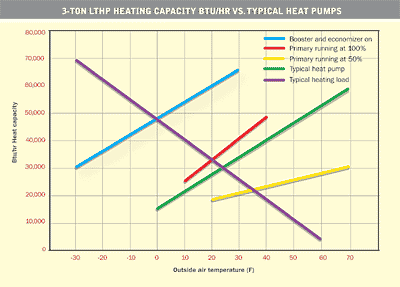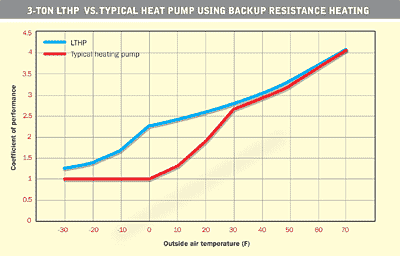Can a New Kind of Heat Pump Change the World?
Efficiency counts: how the LTHP works
As the temperature starts getting near freezing outside, the amount of heat that can be absorbed by the liquid refrigerant boiling in the evaporator decreases. This is because the pressure of the boiling liquid (measured in pounds per square inch) inside the evaporator decreases, and so does the density of the vapor (measured in pounds per cubic foot) the boiling liquid turns into. This causes two problems. First, the compressor has to work harder to pump it because the pressure has dropped. Second, because the amount of heat that vapor can carry is proportional to its density, the compressor doesn't have the capacity to deliver sufficient heat from the outside air to keep the inside of the building warm. As the temperature continues to go down, the situation worsens and, at 30 degrees Fahrenheit, the backup resistance built into most air-source heat pumps turns on.
The most obvious way to solve the problem would be to put a really big compressor into the system. But when it's not very cold outside, this overcapacity would cause the system to be so inefficient that it would be counterproductive. So instead, Shaw decided to add a second compressor, which he calls a booster compressor (see page 164, diagram 2). This is installed between the evaporator coil and what he calls the primary compressor-the compressor that's already present as standard equipment in every heat pump. Most of the time, the booster compressor would be bypassed, and only the primary would compress the vapor that is generated in the evaporator. When the vapor pressure and density dropped below a certain point, however, the booster compressor would be allowed to come on if the outdoor air temperature had dropped below a certain point and the thermostat inside the building is also calling for more heat. The booster compressor has a much larger displacement than the typical primary compressor, so when it is enabled, it can move many more cubic feet of vapor per minute. The LHTP's performance can be enhanced in the future when variable speed booster compressors are introduced.
|
Shaw also knew that in most heat pumps, even after the liquid refrigerant has given up much of its heat to the condenser, it is still pretty warm. When it gets really cold outside, this warmth causes as much as 40 percent of that liquid to vaporize as it goes through the expansion valve. It would be better if it cooled first. That way, more of the refrigerant would remain in liquid form, so it could be boiled later on in the evaporator coil, where it absorbs heat from the outside air while changing states. Shaw figured that one way to cool the refrigerant would be to "donate" some of its surplus heat to a process that would create a source of high-density vapor that would bypass the evaporator coil altogether and be sent directly to the primary compressor.
Shaw calls the device he uses to do this a subcooling economizer (see page 165, diagram 3). It is a heat exchanger that is placed between the condenser and the expansion valve. It splits the refrigerant liquid coming from the condenser into two streams. The majority of the refrigerant passes through one side of the heat exchanger, where it gives up the heat necessary to vaporize a smaller stream of refrigerant being fed into the other side of the exchanger. This vapor is then sent to a point between the booster compressor and the primary compressor, while the larger stream of liquid refrigerant, now cooled significantly, is sent through the expansion valve and on to the evaporator coil, where it boils into vapor.











